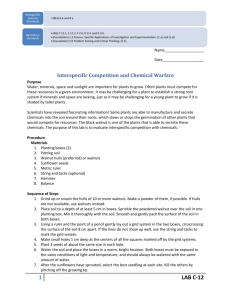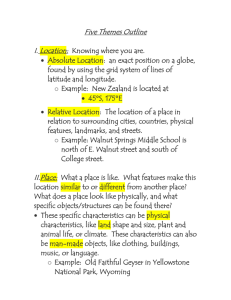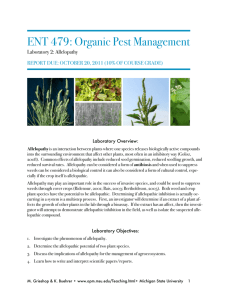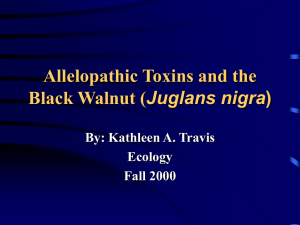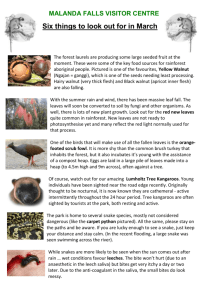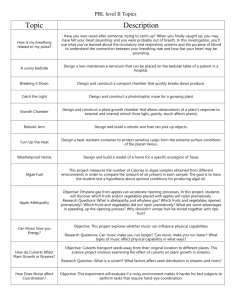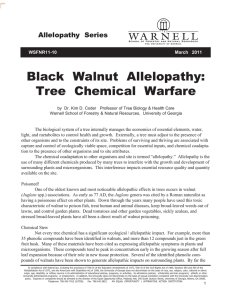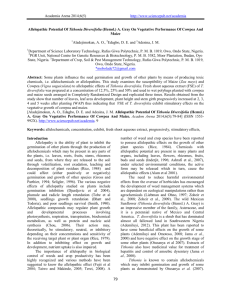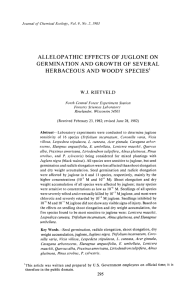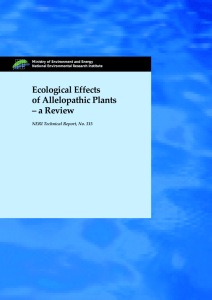allelopathy lab info f11
advertisement
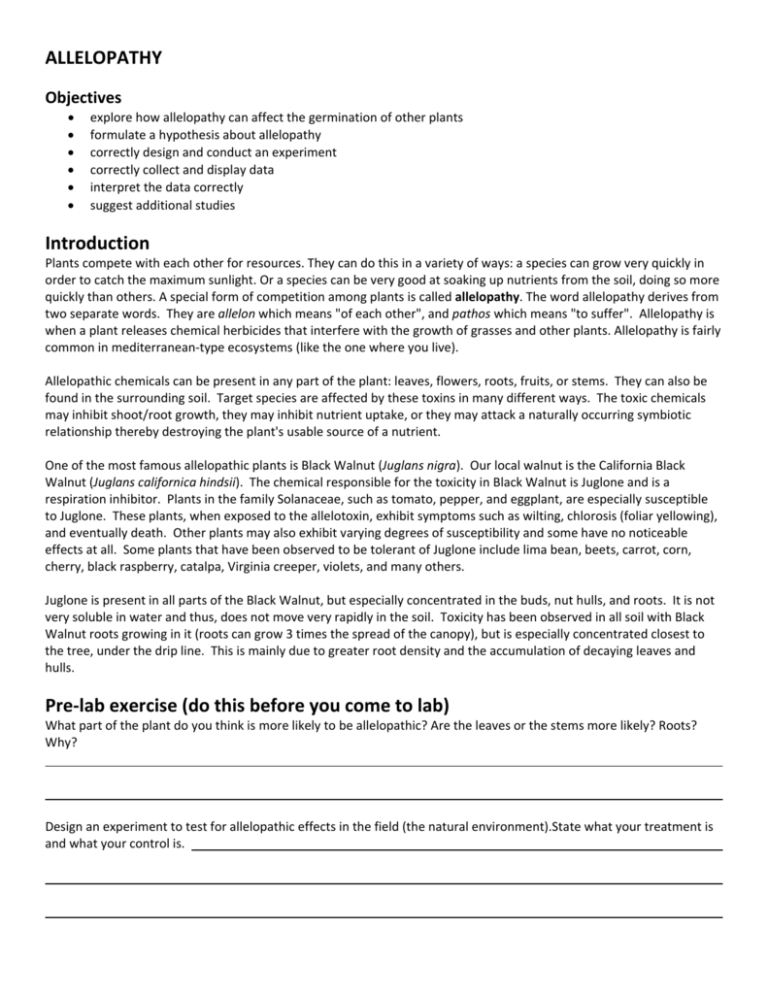
ALLELOPATHY Objectives • • • • • • explore how allelopathy can affect the germination of other plants formulate a hypothesis about allelopathy correctly design and conduct an experiment correctly collect and display data interpret the data correctly suggest additional studies Introduction Plants compete with each other for resources. They can do this in a variety of ways: a species can grow very quickly in order to catch the maximum sunlight. Or a species can be very good at soaking up nutrients from the soil, doing so more quickly than others. A special form of competition among plants is called allelopathy. The word allelopathy derives from two separate words. They are allelon which means "of each other", and pathos which means "to suffer". Allelopathy is when a plant releases chemical herbicides that interfere with the growth of grasses and other plants. Allelopathy is fairly common in mediterranean‐type ecosystems (like the one where you live). Allelopathic chemicals can be present in any part of the plant: leaves, flowers, roots, fruits, or stems. They can also be found in the surrounding soil. Target species are affected by these toxins in many different ways. The toxic chemicals may inhibit shoot/root growth, they may inhibit nutrient uptake, or they may attack a naturally occurring symbiotic relationship thereby destroying the plant's usable source of a nutrient. One of the most famous allelopathic plants is Black Walnut (Juglans nigra). Our local walnut is the California Black Walnut (Juglans californica hindsii). The chemical responsible for the toxicity in Black Walnut is Juglone and is a respiration inhibitor. Plants in the family Solanaceae, such as tomato, pepper, and eggplant, are especially susceptible to Juglone. These plants, when exposed to the allelotoxin, exhibit symptoms such as wilting, chlorosis (foliar yellowing), and eventually death. Other plants may also exhibit varying degrees of susceptibility and some have no noticeable effects at all. Some plants that have been observed to be tolerant of Juglone include lima bean, beets, carrot, corn, cherry, black raspberry, catalpa, Virginia creeper, violets, and many others. Juglone is present in all parts of the Black Walnut, but especially concentrated in the buds, nut hulls, and roots. It is not very soluble in water and thus, does not move very rapidly in the soil. Toxicity has been observed in all soil with Black Walnut roots growing in it (roots can grow 3 times the spread of the canopy), but is especially concentrated closest to the tree, under the drip line. This is mainly due to greater root density and the accumulation of decaying leaves and hulls. Pre‐lab exercise (do this before you come to lab) What part of the plant do you think is more likely to be allelopathic? Are the leaves or the stems more likely? Roots? Why? Design an experiment to test for allelopathic effects in the field (the natural environment).State what your treatment is and what your control is. Methods Work in groups of 2‐4 students. Your group should have at least 2 people you haven’t worked with yet. Introduce yourself to your group members. Get their contact information. Your group will devise 2 experiments based on what you know about the allelopathic properties of black walnut. I have provided you with different parts of the tree. You might want to look at differences in allelopathic effect of different plant parts. I also have collected soil from under black walnut trees. You may want to assess the effects of the allelopathic toxin in the soil under the tree. You also can make a slurry of the allelopathic chemical (allelotoxin). You may want to investigate how different concentrations of the allelotoxin affect plant growth. What amounts of that chemical are most effective against other organisms? Whatever you choose, you will need to explain why you are choosing to do that particular experiment. You will want to carefully note all your methods so you can write them up in your lab report. Do this as you go. Discuss what you want to test with your group. Write down your hypotheses. Hypothesis 1: Justification for this hypothesis: What is your control? What is your treatment variable? What are you measuring? How many replicates are you going to have? What is a replicate in this case? Hypothesis 2: Justification for this hypothesis: What is your control? What is your treatment variable? What are you measuring? How many replicates are you going to have? What is a replicate in this case? Materials The following plant parts are from California Black Walnut: leaves, nut hulls (be careful – the nuts stain skin and clothes), roots, and soil (removed from a range of areas starting at the trunk of the tree and moving out beyond the drip line). Leaves: Crumble leaves and place in cheesecloth. Attach cheesecloth inside of Petri dish lid. Put a moistened piece of filter paper on bottom of Petri dish and place tomato seeds on filter paper. Make sure that the leaves are not touching the seeds. Put a rubber band around the dishes. Label all dishes with your initials and treatment. Put on windowsill. Nut Hulls: Pulverize the nut in the blender. Decide on whether to add water or leave as is (or do a comparison of both ways). Place the nut juice in a Petri dish that has been lined with filter paper. Place seeds on filter paper. Cover, put a rubber band around dish and label dish with your initials and treatment. Place on windowsill. Roots: Do same as nut hulls procedure. Soil: Place some potentially allelotoxic soil into containers. Place a known un‐contaminated soil into other containers (control). Plant seeds into each. Label your pots with your initials and the treatment. Place on tray in random manner and then take to the greenhouse. Tomato Seed Dose/Response Bioassay: Make a concentrated slurry of black walnut leaves (or nut hulls). To do this, place 25g of plant material in blender with 50 mL distilled water. Blend long enough to disrupt cells. Push a piece of cheesecloth into a large funnel and place the funnel in a large flask. Pour the plant extract through the funnel, filtering out plant material to get a clear solution of plant compounds. This will be your concentrated allelotoxin. Dilute it with known quantities of water (you will decide as a group what these quantities will be – then you will label all flasks with concentrations). Place 5 mL of allelotoxin in a Petri dish lined with filter paper. Place tomato seeds on paper. Cover, place rubber band around Petri dish, and label dish with your initials and treatment. Place on windowsill. Measurements We will wait one week and then collect the data from this experiment. You can measure the number of seeds that germinate and/or the length of the radicle of each seedling. The radicle is the first part of the plant to emerge from the seed – it is the embryonic root of the plant. Decide as a group what you will measure. Record your methods carefully so you can write your lab report accurately. Data analysis 1. You will produce descriptive statistics. You will have to calculate means and variance (in the form of a standard deviation) for each of your measurement variables. You will produce one graph (or more if necessary) for each of your experiments. Think about whether you will graph all your data points or your means. If you do not understand what to do and you cannot get the answer from a group member, ask the instructor. Do not leave the lab without understanding how to do this. I will assume that you do understand how to do this unless you ask. 2. You will produce an inferential statistic for each hypothesis. The type of statistical test and analysis will depend on how you set up your experiment. The instructor will tell you which test to use and can guide you on how to perform the statistical test. Computers have been set up in the lab. Again, if you do not understand this and cannot get the answer from a group member, ask the instructor. Do not leave the lab without understanding how to do this. I will assume that you do understand how to do this unless you ask. What does a p‐value tell you? What to turn in 1. You will write a short lab report with the following three parts: Methods, Results and Discussion (sometimes called Conclusion). Consult the handout on writing lab reports again. Also read the comments again for your previous lab report. Make sure to talk about why you think you got the results you did from the standpoint of the biology of the organism. If your results don’t support your hypothesis, give a reasonable explanation that involves the biology of the organism – don’t say you did it wrong. State at least 2 additional studies that would be interesting to do now that you know what you do about allelopathy (the studies don’t necessarily need to about black walnut trees). 2. Your graphs (if you hand‐draw them you will need to do it on graph paper) 3. A table (or 2) with your data presented neatly 4. This lab sheet with the answers to the questions (or put the answers on another sheet and turn that in) Some questions you may want to address in the discussion of your report (but it’s not mandatory – this is just a guide): • Why would certain amounts of allelotoxins be more effective than others? • How would this affect susceptible organisms’ defenses? • What other factors may be involved? • How does this affect the plant’s competitive ability? • Is there a trade‐off involved in producing an allelotoxin? What might it be? How you will be graded pre‐lab assignment (5 pts) questions on the lab sheet (5 pts) graphs & data (10 pts) lab report: methods (10 pts) results (5 pts) discussion (15 pts) Additional questions: Who are your lab partners? If they were an animal, which animal would it be? (they have to answer this – not you) Do you think you all contributed a fair amount? If not, explain (your answers are confidential). del Moral, Roger, and Cornelius H. Muller. 1969. Fog drip: a mechanism of toxin transport from Eucalyptus globulus. Bulletin of the Torrey Botanical Club 96(4):467‐ 475
